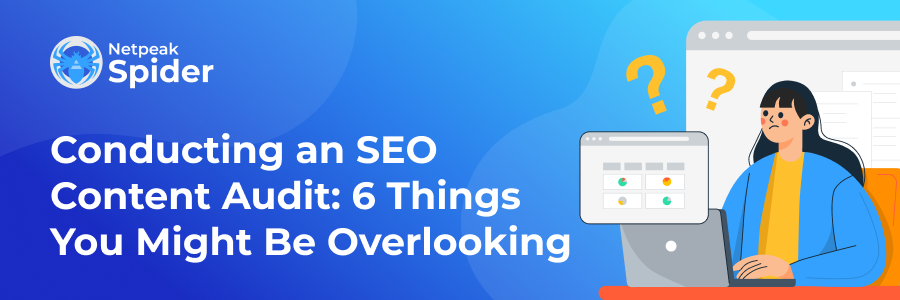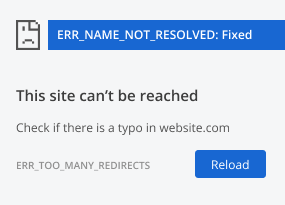Top Tips for Conducting Efficient SEO Content Audit
Site Audit Issues
The primary purpose of any SEO content audit is to improve the weak spots in your website's performance. It also helps you find new opportunities to promote it and increase its organic reach.
In this post, we'll discuss the main points to consider when conducting a content SEO audit to ensure its maximum efficiency.
The purpose of running SEO content audits
A site content audit is a consolidated analysis of the essential performance metrics that impact your website's search engine rankings, organic reach, and reputation. After running an audit, you'll see what areas of improvement you need to focus on, which aspects perform just fine, and whether you can take additional steps to streamline your optimization strategy.
SEO audits give you an overarching overview of your website, from technical aspects to potential content creation ideas you can implement. Moreover, you can compare a website to your competitors and see whether you can use some of their strategies or top-performing keywords to rank higher in search results. Overall, you'll be able to explore your website from different perspectives and thus implement a better SEO strategy.
Things you should look for while running a content audit
Apart from the well-known key SEO strategies and basic metrics, there are specific technical aspects many website owners need to pay more attention to. Below, you'll find the list of such optimization parameters that you should include in your website checkups and see how they impact its overall performance.
Fully accessed and rendered content (JavaScript SEO)
JavaScript is a programming language that can power up your content, from product sliders to animated or dynamic site navigation. It helps you deliver rich, engaging content to your users. However, advanced JavaScript-based content can be complicated and time-consuming to process, mainly if your website relies on client-side rendering in the browser.
The problem with this approach is that Googlebot can only sometimes process JavaScript-driven website content, which may result in emerging errors, and it's your task to audit your site for them. This way, you'll make sure your content is fully rendered and indexed.
Do search engines detect all on-page content?
One of the biggest JavaScript-related issues is that search engine bots can't detect and crawl all the critical content on your pages. These problems may result from coding mistakes or due to the fact that the content on your site wasn't available for indexation and rendering.
Are there URL accessibility issues on a website?
Another popular JavaScript-related issue relates to your site’s URLs.
Many JavaScript frameworks, by default, don't create unique URLs you can access individually, which is the case with single-page applications and particular web apps. The page contents dynamically change for a user, yet the URL remains the same.
When search engines can’t access every URL on a website, it creates many SEO problems, so you'll have to check if yours are available and indexable.
If there are links that need indexation but can't be found, there's a problem you must address. Here's what your page could contain to cause trouble:
- Blocked resources;
- Noindex;
- Nofollow;
- A different canonical link;
- Redirects handled at a page level instead of at the server request.
- Fragment or hash URL.
Audit Core Web Vitals and optimize your site's load speed
Optimizing your website's page speed can help significantly improve your SEO strategy.
The three Core Web Vitals are what you should be looking at here. They measure both page speed and UX variables. These metrics include:
- Largest Contentful Paint (LCP) — it shows the time needed for primary on-page content to become visible to users.
- First Input Delay (FID) – measures the response time when a user can interact with a page (e.g., clicking on a link or interacting with JavaScript elements).
- Cumulative Layout Shift (CLS) – calculates the number of layout shifts that ultimately affect users' ability to interact with content.
Measuring Core Web Vitals
You can easily measure your page's Core Web Vitals via several commonly used tools. The main one is the User Experience Report by Google, which collects real user data and displays it via services like PageSpeed Insights and the Search Console.
- Within Google Search Console, the Core Web Vitals feature uses the data gathered from the User Experience Report to reveal the issues on your website.
- PageSpeed Insights analyses the performance of your pages and suggests relevant improvements for both mobile and desktop browsers.
- The Chrome Web Vitals extension is great for internal audits and measuring up against your competitors.
Audit Index Bloat and Keyword Redundancies, and Prune Mindfully
Pages containing low-quality, duplicate, cannibalizing content or no-content pages contribute to wasted crawl budget, index bloat, and keyword dilution. In this case, auditing index bloat can help you fix this issue.
What can cause index bloat?
Index bloat occurs when a site has too many indexed URLs when, in fact, they shouldn’t be. This happens when Google or other search engines find and index more URLs than needed or specified in the sitemap. It’s a typical case for large websites like eCommerce platforms or aggregators.
Here's what index bloat can come from:
- Dynamically generated URLs;
- User-generated content;
- Coding mistakes like broken URL paths;
- Subdomains;
- Orphan pages;
- Having too many pages covering the same topic or keyword.
There are several different ways to identify index bloat. Let's examine the most efficient ones below.
Run a cannibalization analysis
You may stumble upon cannibalization issues if you have more than one URL ranking for the same keyword. In many cases, your content will end up competing against itself, and your page will rank on pages with little to zero organic visibility.
Here's what you can do as part of your content SEO audit to get rid of cannibalization issues on your website:
- Update the content on one of the pages as well as internal anchor links there so it'll no longer be competing;
- Retire and redirect low-performing pages;
- Consolidate the pages into one. Do this by leveraging the best content from both to cover the subject matter comprehensively. Use a higher-performing URL and redirect the other to a new page if possible.
Compare index coverage and sitemaps in GSC
First, select the property you’d like to audit within Google Search Console, like the HTTPS vs HTTP properties of a domain, together with any extra subdomain variations. In this case, it’s easier to get data from one property and overview URLs through all associated subdomains.
Whether you’re utilizing one domain property or cross-auditing different ones, the next step is to get an XML sitemap correctly. Sometimes, analyzing the sitemap can show you the signs of index bloat, like pagination URLs. This is the case with websites on platforms that automatically generate XML sitemaps disorganizedly.
Google Search Console offers handy tools to help you identify and clean up your website's index bloat. Under the Index option, you can select Coverage to see the pages Google has indexed.
Removing index bloat and faulty URLs
Once you’ve determined which URLs contribute to index bloat or are redundant (and / or duplicate), it is time to eliminate them.
Before removing them all, assess these URLs and the best pruning ways first. For instance, some links might be gaining organic traffic or backlinks, and removing them instead of redirecting can result in losing all SEO value you could reallocate.
Here's how you can assess the value of URLs to help you determine the best way of pruning them:
- Review organic metrics in Google Analytics: organic traffic, conversions, user behavior, and engagement to evaluate the SEO value of a URL;
- Review All User segment metrics so you won't accidentally prune content with high business value;
- In Google Search Console, the Performance and Search Results tabs will help you see how particular pages perform through different queries;
- Other SEO-related tools like Netpeak Spider or Ahrefs can help you see if a URL has any backlinks and evaluate how well a page performs organically.
Determine and enhance pages with little visits
Pages with high exit rates aren't the same as the ones with high bounce rates, yet you can apply many similar improvements to both. Unlike the bounce rate, which is associated with the entrance pages, the exit rate shows how often users exit from a page after entering any number of pages. The exit rate is calculated as the following percentage: the number of exits divided by the number of page views.
Pinpointing pages with high exit rates
Google Analytics detects the pages with high exit rates — you can find this data in the Site Content section in the Behavior tab. Under All Pages, a % Exit column will show all website pages' exit rate metrics.
The Exit Pages report is a good start in assessing which URLs your visitors are dropping off the most. It’s best to set the date range of this report, like the last 6-12 months. Depending on the size of your site, you may want to export the data on more than just the top 10 URLs shown by default, which you can also manage in the report settings.
Improving exit pages and reducing drop-offs
Finding pages with high exit rates is one thing while integrating changes to reduce drop-offs is another. While some problems might be obvious (slow loading pages, broken links, media not rendering, etc.), deciding where and how to improve content and user experience requires investigation.
Here is a series of tips to help you reduce exit rates, improve engagement, and boost conversions:
- Enhance the UX and readability: make sure you include easily digestible content by keeping it organized and simple to navigate;
- Speed up slow pages: slow page loading time contributes to high exit rates the most. Hence, you must prioritize improving Core Web Vitals, leveraging Accelerated Mobile Pages, optimizing images, and other actions that can increase the load speed of your page;
- Test cross-browser compatibility: it’s necessary to make sure you've done all proper testing across all browsers so the content renders without any technical issues;
- Add CTAs: add graphics, buttons, and other interactive elements to catch user attention and invoke the proper action;
- Improve internal linking: your page copy needs to include internal links to other proper and related site pages. It directs users to relevant content they may be interested in, thus making them stay longer on the website;
- Include related content: to minimize exists, try including links to related content (blog posts, useful resources, etc.). Placing it naturally within the main page content and adding thumbnails for better visualization will also increase the session time.
- Avoid intrusive pop-ups and too many ads: pages riddled with intrusive pop-ups or too many banners almost exclusively have high exit rates, so getting rid of excessive promotional content can significantly help in this case.
Detect content gaps by researching competitors and keyword data
Another crucial step in any content audit for SEO is searching for content gaps to define untapped topics and generate new content ideas. The best insights usually come from analyzing competitors and testing out the types of content they’re already publishing (which you haven't yet). In this case, competitive content audits are the best to combine with keyword research to help you find and add new, well-performing ones to your website.
Take a look at your competitors’ SEO content strategies
Exploring close competitors concentrated in your niche will help you get valuable insights rather than analyzing giant websites like Amazon. You can generate many new ideas once you see what topics your competitors are covering, what SEO content audit strategies they’re using, and how much effort they've invested in them.
Of course, you should support your research with tangible data. Tools like SEMrush, Netpeak Spider, Ahrefs, Sistrix, and others are super-helpful in detecting content gaps and discovering the opportunities they can bring.
Take non-SEO segments and the overall conversion value into account
As you gather data to support your research, better pull and evaluate user data through various user segments, especially if you use crawling tools integrated with Google Analytics API.
It’s a common mistake to prioritize only the data from the organic user segment—this would only mean you’re overlooking essential data from other channels and segments. Neglecting the rest of the non-SEO segments can lead to the accidental retirement of your website's pages, even the high-quality ones.
Dashboard your data and bring action to the audit
One last recommendation would be assembling your research insights into a dashboard to properly structure your findings and easily define actionable next steps.
It’s also valuable to run a manual target page review — if you have a blog editor, copywriter, or content strategist, they'd be perfect for the task. Here are some extra columns you could add to a dashboard to enrich your research and create better copy for your site:
- Old or outdated content;
- Off-brand tone;
- Wrong tone or target audience.
Content audits for SEO will help you define the value of site optimization and the next steps for appropriately re-framing your content. Thanks to a convenient dashboard, you'll be able to quickly set priorities and keep communication straight within your content team. Here's what else will help you monitor your website's performance:
- Content category — helps you see which categories are well-performing or not and why;
- Business alignment — shows whether you need to add extra content to support and highlight product features;
- Customer funnel stage — this section will help outline the target funnel stage for individual pages and specify different goals per stage;
- Other notes and action items — this includes any edits or general enhancements that give a subjective view for improvement.
These insights are invaluable to developing an excellent content audit strategy. Besides bringing actionable creativity to your SEO strategy, they help you create more engaging, user-oriented content that will drive significant organic traffic volumes and high conversion rates.
Conduct insightful website audits with Netpeak Spider
If you need a trusted tool to help you run SEO content audits, we recommend trying Netpeak Spider.
This website crawler runs in-depth SEO audits and delivers high-quality, detailed reports in a few minutes. Here, you can analyze your website's SEO and technical metrics and enrich your reports by retrieving data from Google Analytics and Search Console. Moreover, Netpeak Spider can detect over 100 website-related issues, so you'll always stay on track and know what needs improvement.
The tool is straightforward to work with, too. Here's all you need to do to get your website's checkup results:
- Create a list of URLs you need to check and upload it into Netpeak Spider; alternatively, you can paste your list into a built-in search bar;
- On the right sidebar, pick the parameters you want to analyze;
- Click "Start" and launch the crawling process.
Let's see how you can integrate the Google Services API and use Netpeak Spider to check your site's keyword rankings.
Step 1. Launch Netpeak Spider and crawl the domain
>>>>> gd2md-html alert: inline image link here (to images/image1.png). Store image on your image server and adjust path/filename/extension if necessary.
(Back to top)(Next alert)
>>>>>

Img: http://img.netpeaksoftware.com/estrella/1692957463877.png
Alt: Use our Netpeak Spider tool to check site rank and run productive website crawling quickly.
First, download Netpeak Spider and activate our free trial. Paste the links into the search bar. After the crawling, you'll access the results table with a detailed breakdown of all the essential on-page parameters.
Step 2: Set up an integration with Google services
In the Settings section, integrate Google Analytics and the Search console into the app by adding the respective API. Adding these two services will help you quickly detect critical issues with your site rankings and provide insights on improving your page's positions in search results.
Step 3: Retrieve the data about your website's average position
Check your web page's average position in the search results to see how it performs over specific periods. Once you've integrated the Search Console API, you can start the crawling process. After you receive the results, you'll see if using the current keywords still makes sense, or maybe it's time to select the more appropriate and higher-ranking ones.
You can try the app for free first to see if it fits your daily SEO needs. It's now accessible for Windows and macOS users, so you can pick any preferred OS and check your site data in real-time.
Bottom line
A comprehensive site content audit is an invaluable part of your SEO strategy. It provides you with deep insights into what performs well and what needs improvement on your website. This way, you analyze user behavior and define what works well for your competitors, what triggers high exit rates, etc.
Conducting a website audit is now easier than ever since many handy tools, like Netpeak Spider, will do the job for you. Try the app and streamline your content strategy this instant!


.png)
